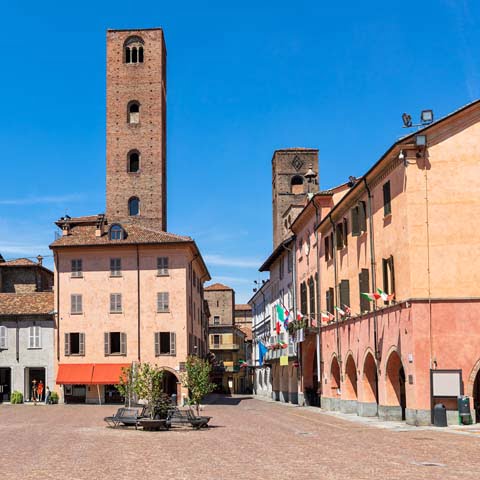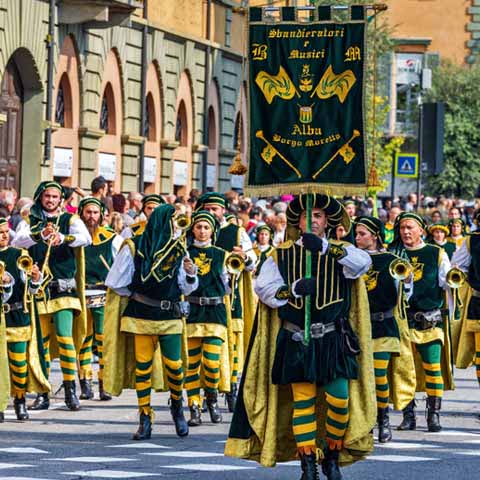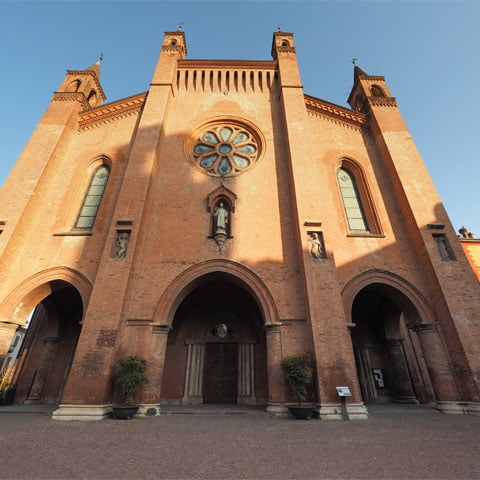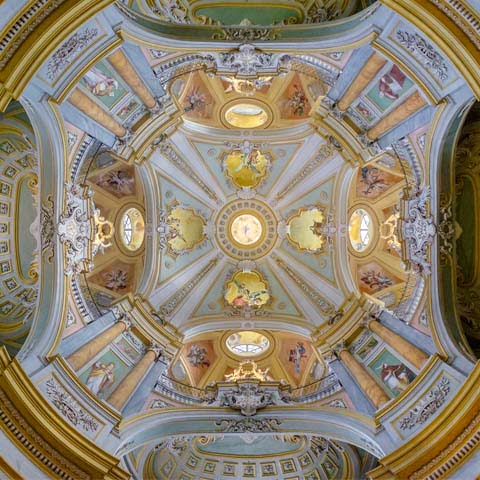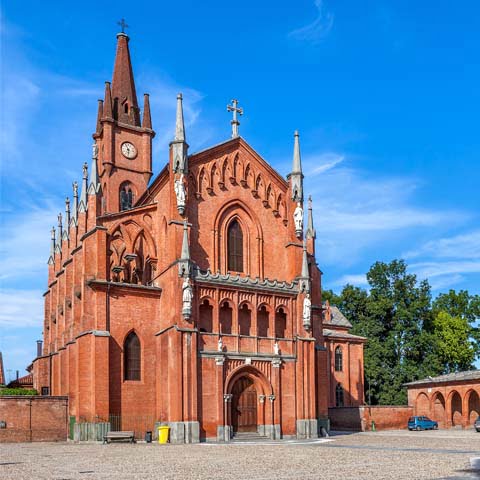The charming and picturesque little town of Alba sits approximately 40 miles outside the busy city limits of Turin. This historical medieval town is home to gorgeous examples of architecture such as historical churches and city towers and has been inspirational for Italian artists such as Barnaba da Modena, Macrino d’Alba, and Giuseppe Pinot-Gallizio. With literary and cinematic contributions tucked away inside one of the finest wine regions in all of Italy, Alba is full of rich art and history, making this lovely city a favorite for those hoping to take in authentic Italian culture minus the crowds.
ARCHITECTURE
The Cathedral of San Lorenzo, also known as Duomo di Alba, is estimated to have been built circa the tenth or eleventh century in a Romanesque style. However, the structure experienced several periods of vast renovation and construction during the years since, and the present structure of the church dates back to the fifteenth century. The main elements of the current Gothic façade date back to the nineteenth century. Composed of red bricks, the exterior features four column towers, a rose window, arched windows, and arched entryways. Inside the church a uniquely designed wooden choir, created by artist Bernardino Fossati in the sixteenth century, is particularly of note. Another point of interest inside the church is the vaulted ceiling that was painted by Carlo Costa in 1870 to resemble the starry night sky.
Also in the center of Alba, travelers will find the Church of San Domenico, which dates back to the fourteenth century and was built by the Dominican friars. Although the church has been renovated over time, with the most recent works completed in the 1970s, it has maintained its largely Gothic style. The front façade of the church is tan in color and features a large wooden door, an ornate arch portal over the door, two tall arched windows, and one circular window. Like the Duomo, the façade also features four column towers. Although construction over the years, including the addition of several chapels, is responsible for covering some of the interior frescoes, sacred frescoes from the fourteenth and fifteenth century can still be seen in part. While the church is consecrated and regularly holds mass, it is interesting to note that the church is also a hotspot for local events, exhibits, and concerts.
Of special artistic and historical significance is the Church of San Giovanni Battista, which is the oldest church in Alba after the Duomo, though not much is known about its primitive structure. The current church is believed to have been built between the twelfth and thirteenth centuries. The church underwent almost a complete reconstruction in the middle of the seventeenth century, which resulted in its current white and cream hued Baroque style. The church is largely rectangular and features a side bell tower. The interior is full of elegant architecture that gives the church a highly reverent and sacred feel. Visitors touring the Church of San Giovanni Battista are inexplicably drawn inside to admire the wealth of gorgeous paintings by artists such as Barnaba da Modena and Macrino d’Alba.
The eighteenth-century Baroque style Church of Santa Maria Maddalena sits in the heart of Alba contrasting the city’s largely medieval character. The exterior of this church is misleading with its unfinished brick façade and large wooden main door. The interior of the church is full of amazing historical finds such as a large wooden choir, eighteenth century frescoes, and a beautiful silver urn made by Pietro Bodani. The church has strong historical ties to Alba’s Dominican Monastery.
In addition to these magnificent churches, Alba is home to several city towers built during the fourteenth and fifteenth centuries. Alba was once nicknamed “the city of a hundred towers” though only a handful remain standing to this day, with the most well-preserved towers located between Via Cavour and Piazza Risorgimento. Many of the remaining towers were eventually lowered or incorporated into other buildings over the years, such as the Torre di Casa Chiarlone. Another example is the bell tower of the Duomo, which is somewhat rare as it is actually two bell towers in one, from two different centuries. Many visitors enjoy climbing this unique structure for the experience and the spectacular views.
Also nestled in the historic center of Alba stands the Church of San Giuseppe, an architectural gem featuring both medieval and Roman components. Constructed in 1643 on a site that was previously home to a private residence, the church was built upon the house’s archaic ruins and absorbed its Roman theater vault as well as a 12th century tower that to this day serves as a reminder of the structure’s ancient history. The church’s mostly unassuming and minimalistic façade belie the treasures within. Exquisite frescoes dating back to 1720 adorn the interior walls, and an eighteenth century organ stands watch over all who enter the Church of San Giuseppe’s sacred halls.
Just a block south is the Palazzo Comunale, or the Town Hall of Alba. Erected on the ruins of ancient Roman structures in the fourteenth century, the Palazzo Comunale borders the Piazza Risorgimento. Visitors exploring the building’s interior are regaled with stunning frescoes and historic paintings, such as Macrino d’Alba’s 1501 masterpiece Virgin and Child. Also on display are more recent works from artists like inventor and painter Pinot Gallizio, who is represented with a 1961 industrial painting.
ART
Barnaba da Modena, was a fourteenth century Italian painter that spent time in the Piedmont area, specifically in the Church of San Giovanni Battista, where his painting entitled Madonna delle Grazie can be admired. Although he dedicated much of his work to Genoa, where he lived, he is also known for contributing works to Piedmontese churches. One of Modena’s more famous works, Virgin and Child, is part of the collection of the Museum of Fine Arts in Boston.
Renowned Italian fifteenth and sixteenth century painter Macrino d’Alba, whose birth name was Gian Giacomo de’Alladio, was quite active in his native region of Piedmont. D’Alba is primarily recognized for his portraits and altarpieces. In Alba specifically, Macrino d’Alba’s works are present in the Palazzo Comunale as well as the Church of San Giovanni Battista and the Church of San Francesco.
A more recent painter, twentieth century artist Giuseppe Pinot-Gallizio, was also born in Alba as well. In addition to being a painter, Pinot-Gallizio was a chemist and a scholar of several subjects such as archaeology and culture. His background in chemistry is said to have aided him in developing unique painting techniques, and the majority of his works were industrial paintings (very large canvases designed to fill a big space). His works are on display around the world, including the Centre Pompidou in Paris, the Stedeljik Museum in Stockholm, and the Museo Nacional Centro de Arte Reina Sofía in Madrid.
LITERATURE
Beppe Fenoglio, whose full name was Giuseppe Fenoglio, was an Italian twentieth century writer. He is most often associated with writing about the Italian resistance movement during World War II and the rural land of the Langhe. Fenoglio frequently pulled from his own personal experiences in his writing. One of his works with a close connection to Alba is I ventitré giorni della città di Alba, which translates to “the twenty-three days of the city of Alba” and refers to the 23 days that Alba’s resistance fighters were able to hold the city after capturing it on October 10, 1944. This collection of 12 short stories was Fenoglio’s first published work and it chronicles events during the partisan resistance, as well as daily life for farmers during and after World War II. One of Fenoglio’s novels, Il partigiano Johnny, follows a young man active in Alba’s resistance movement. After Fenoglio’s sudden death in 1963, many of his works were published posthumously, receiving wide acclaim.
Cesare Pavese, one of Italy’s greatest writers of the twentieth century, was a native of the Langhe Area born in a town called Santo Stefano Belbo, just over 15 miles east of Alba. Winner of the prestigious Premio Strega, Italy’s foremost literary prize, Pavese was renowned for his novels, poems, short stories, and translations of works by English and American writers. Pavese’s beloved Langhe Area was often featured in his writing. Pavese, as well as other key cultural figures of the Alba area like Beppe Fenoglio and Giuseppe Pinot-Gallizio, frequented Caffè Calissano, a coffee shop dating back to the nineteenth century that can still be visited today.
MUSIC
The annual Alba Music Festival is the perfect symbol of the city’s love of music. Taking place over several weeks during the summer, this event is a celebration of international music. Performances are conducted across the area, including at historical landmarks such as the Church of San Domenico and the Ferrero Foundation Auditorium. This celebration of music spans multiple locations and genres, making it one of the most prominent musical events in northeastern Italy hosting orchestras, chamber groups, and composers.
CINEMA
Despite the beauty of the city of Alba, it is largely unknown to the film industry on an international scale. However, events like the annual Alba Film Festival and its celebration of Italian films have established some cinematic ties in Alba. In the twentieth century, Alba served as the setting for Il partigiano Johnny, a film adaption of Beppe Fenoglio’s novel of the same name. The Langhe Area as a whole was also featured in the 2014 film The Trip to Italy, which follows Rob Brydon and Steve Coogan’s culinary travels through the Piedmont, Liguria, and Tuscany regions, as well as Rome and the Amalfi Coast.
Don't just see Italy, live it.
Your dream trip to Italy has never been closer
No more endlessly scrolling travel sites. Our travel experts will craft the perfect, one-of-a-kind trip just for you.

300+
DESTINATIONS
We offer more Italian destinations than any travel site. Do and see more with Trips 2 Italy.
1 (of a kind)
ITINERARIES
Because your dream trip to Italy should be designed for you, not for the masses.
100%
PEACE OF MIND
From flights and accommodations, to food and activities - we take care of every detail.

